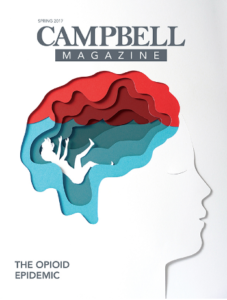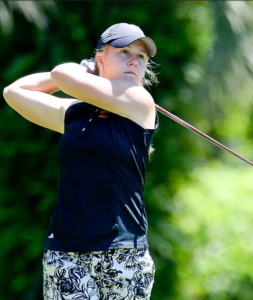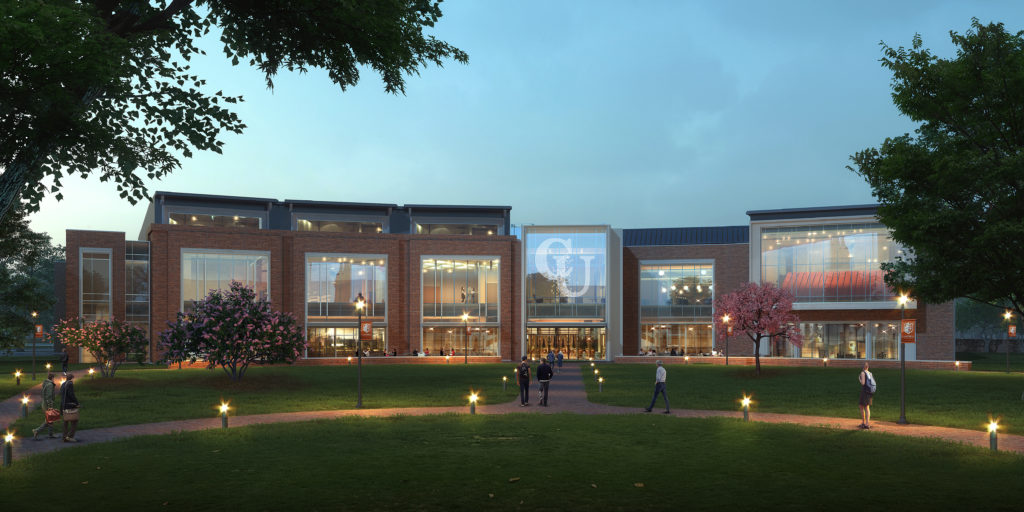The past year marked the beginning of a lot of change at Campbell University, from the design and construction of new iconic buildings on campus to a new logo and wordmark that both looks to the future and honors the past. Before we enter what is sure to be an exciting and important 2018, we’re honoring the Top 10 events and stories that marked an exciting 2017 at Campbell.
10
Medical school’s opioid curriculum launches during ‘national emergency’
The Jerry M. Wallace School of Osteopathic Medicine began the year by launching its Opioid Abuse and Drug Abuse Curriculum in January in response to the nation’s epidemic that kills an average of 78 Americans each day.
 Nine months later, President Trump declared the epidemic a “national emergency,” a move the University and health care industry hope frees up funds and resources to educate future doctors on pain management and create resources for those struggling with these highly addictive narcotics.
Nine months later, President Trump declared the epidemic a “national emergency,” a move the University and health care industry hope frees up funds and resources to educate future doctors on pain management and create resources for those struggling with these highly addictive narcotics.
North Carolina is home to four of the Top 20 cities in the United States for highest rate of opioid abuse — No. 1 Wilmington, No. 5 Hickory, No. 12 Jacksonville and No. 18 Fayetteville — according to a 2016 study by Castlight Health Inc., a nonprofit health care information company. In 2015 alone, prescription opioids like hydrocodone (used by doctors to treat pain) and illicit drugs like heroin and illegally manufactured pills claimed more than 1,200 lives in North Carolina — a 400-percent increase from 15 years earlier.
Under the direction of Dr. Jim Powers, associate dean for clinical integration and professor of emergency medicine, Campbell Med’s opioid curriculum is designed to educate the next generation of physicians on both the dangers and benefits of opioids and alternative treatments for pain management. The curriculum provides “practical guidance in screening pain patients for substance abuse disorder” and will help future doctors identify when patients are abusing their medications.
“Studies have shown that even brief interventions by primary care providers have proven effective in reducing or eliminating substance abuse by people who abuse drugs but are not yet addicted to them,” said Powers.
9
Campbell Raleigh positions University to better serve adult, nontraditional students
The Campbell University RTP Campus relocated from Morrisville to downtown Raleigh this fall, a move that positions University to better serve students in and around the Triangle by providing a more central location.
The Adult & Online Education program’s Raleigh location joins the Norman Adrian Wiggins School of Law in its building at 225 Hillsborough St. The program offers a variety of unique bachelor and associate degree options. The Lundy-Fetterman School of Business also hosts master of business administration and trust and wealth management programs at the facility.
“Our relocation of the RTP campus gives Campbell a unified and clear presence in the thriving downtown area of Raleigh,” said Mark Hammond, vice president for academic affairs and provost. “Adult and nontraditional learners will benefit greatly from this convenient location.
“Our vision of providing accessible, high-quality programs to all who wish to pursue a college degree is significantly enhanced by this transition.”
8
Conference titles, postseason appearances, All-Americans and winning seasons
Cross Country: The Campbell cross country team had a historic season in 2017, with the men capturing their third straight Big South championship and the women recording their highest finish in program history.
 Women’s Golf: Campbell fell just short in its quest for a team berth in the NCAA finals, but Nadine White (pictured) qualified NCAA women’s golf championship, finishing 57th overall in the tournament.
Women’s Golf: Campbell fell just short in its quest for a team berth in the NCAA finals, but Nadine White (pictured) qualified NCAA women’s golf championship, finishing 57th overall in the tournament.
Men’s Basketball: Campbell finished the year with the second-most wins in the program’s Division I era (since 1977-78) and earned a pair of post-season victories, also the first for the Camels.
Football: The Camels finished 6-5 in its final season of non-scholarship FCS football, only its second winning season since football returned in 2008 after a 58-year hiatus. Campbell was one of 10 FCS programs to average a sellout in 2017, breaking the Barker-Lane Stadium average (5,546) and total (33,276) attendance records for the second straight season. The program joins the Big South Conference in 2018.
Volleyball: For the first time in the program’s history, Campbell earned an invite to a postseason volleyball tournament. Coming off a 20-win season – the team’s most in nearly two decades – the Camels competed in the Women’s National Invitational Volleyball Championship, falling to Temple in the opening round.
Track: Distance running standout Amon Terer took home First Team All-America honors at the 2017 NCAA Outdoor Track & Field National Championships. The Eldoret, Kenya native ended his Campbell career placing fifth overall in the men’s 5,000m final with a time of 14:36.78 at the University of Oregon’s historic Hayward Field. A six-time NCAA All-American, he will undoubtedly go down as one of the most nationally decorated Campbell student-athletes of all time.
7
Luby Wood Hall opens with innovation, student comfort in mind
The traditional picture of a college dormitory includes small rooms, quiet hours and the ever-present roommate. A setting designed around a student’s need to sleep and not much else. That scene is changing, especially at Campbell University where the ribbon was cut this summer on its newest residence hall (not a dorm), Luby Wood Hall.
A campus-wide survey was distributed to undergraduate students living on campus before the project began. Framed as a “Design Your Own Residence Hall,” the survey covered topics like room logistics, shared bathrooms, and study space requirements.
More than 900 responses were taken into consideration to create the 63,800 square-foot facility that sits just inside the eastern entrance to Campbell’s main campus.
The four-story residence hall features 174 single or double occupancy rooms with private sleeping quarters, three full-size kitchens with appliances, laundry facilities, a Provisions-on-Demand (POD) store, a bicycle garage, meeting rooms and lounging areas.
6
Construction begins on new admissions center in Academic Circle
Construction on the new Bernard F. McLeod Sr. Admissions & Financial Aid Center began Sept. 18, with the building is expected to be ready for use by the fall 2018 semester. It will be located in Campbell’s Academic Circle, between Butler Chapel and the future spot for the 100,000-plus square-foot student union (where Baldwin and Kitchin Halls once stood).
The building will be home to the admissions office on the first floor, and the second floor will house financial aid and the business office. Currently, those three offices are separated into two buildings on campus. Meeting rooms and interview rooms in the center will look out over the Academic Circle, facing Campbell’s iconic Kivett Hall and D. Rich Buildings. There will also be a two-story “fireplace room,” providing a comfortable waiting area for prospective students and their families.
“We wanted a place that would be welcoming … a real family-centered location,” said Vice President for Business and Treasurer Jim Roberts. “It had to be a place that was professional as we bring people in, and it had to be a place that was spirited and steeped in Campbell tradition. Those were the basic tenets we wanted as we began planning this building.”
5
Buies Creek Astros bring professional baseball to Campbell (temporarily)
Even in the world of Minor League Baseball — where rural America, ballparks built near cornfields and intimate, familiar crowds are attributes woven into the fibers of the game — Buies Creek is small.
 Yet there it was on Nov. 17, 2016, site for the kind of announcement many towns and cities would give their Main Streets for. There stood Reid Ryan — son of Hall of Fame pitching legend Nolan Ryan and president of the Houston Astros — announcing the arrival of professional baseball. The Buies Creek Astros.
Yet there it was on Nov. 17, 2016, site for the kind of announcement many towns and cities would give their Main Streets for. There stood Reid Ryan — son of Hall of Fame pitching legend Nolan Ryan and president of the Houston Astros — announcing the arrival of professional baseball. The Buies Creek Astros.
The Astros finished second overall in the Carolina League in 2017, bringing through future Major League stars like Kyle Tucker and Forrest Whitley in the process. The High-A affiliate supports the Houston Astros, which won its first World Series title in November featuring players developed in the farm system like the current batch of prospects.
4
Programs strengthen Campbell’s mission to support rural communities
The health and well-being of rural America is at the forefront of a new program at Campbell University supported in part by the Robert Wood Johnson Foundation, the nation’s largest funder solely dedicated to health.
RWJF awarded Campbell a grant in 2017 to fund an 18-month national exploration — the Rural Philanthropic Analysis — designed to create, identify and enhance new ideas and insights to improve the practice and impact of charitable organizations when it comes to supporting healthy, equitable rural communities.
The $730,248 grant provided by RWJF went into effect on June 15 and will allow the project to run through December 2018. The Princeton, N.J.-based foundation — established in 1972 after the death of Robert Wood Johnson II, son of the founder of health care conglomerate Johnson & Johnson — generates roughly $400 million in grants nationally each year. Its goal is to “build a national culture of health, enabling everyone in America to live longer, healthier lives.”
In November, the University and its health science programs partnered with the City of Dunn to open a health clinic in that city that will treat thousands of Harnett County residents annually. Physicians at the new facility in Dunn will offer services in geriatric medicine, osteopathic manipulative medicine, sports medicine and spine and back treatment.
3
Campbell reveals new logo, wordmark and website to launch new brand
A new icon celebrating Campbell’s historic Kivett Hall, a new tagline to support Campbell University’s mission to educate men and women who will become purposeful leaders and a new website designed with prospective students in mind.
![]() All three of these were the result of a year-long Brand & Digital Transformation launched in January of 2017. The initiative grew out of one of Campbell President J. Bradley Creed’s strategic priorities to expand Campbell’s reach and extend its influence.
All three of these were the result of a year-long Brand & Digital Transformation launched in January of 2017. The initiative grew out of one of Campbell President J. Bradley Creed’s strategic priorities to expand Campbell’s reach and extend its influence.
“I have heard others describe Campbell as a hidden gem and the best kept-secret in North Carolina. They meant that as a compliment,” Creed said. “But I want people all across North Carolina, the region, and the nation to know the Campbell name and to recognize Campbell as one of the preeminent private universities that prepares students to make a difference in the lives of others through work, service, and leadership. The refined Campbell brand and website will help us realize this.”
Fueled by a higher calling, our University provides a transformational learning experience that prepares students for servant leadership and equips them with skills and habits to make a difference in the lives of others. The Campbell brand, positioned to offer key messages to targeted audiences, advances Campbell’s mission and reach.
2
University announces new student union will become reality in 2019
By the fall of 2019, the heart of Campbell University’s campus will have an entirely new look and feel. The centerpiece of President J. Bradley Creed’s Campbell Leads fundraising campaign will be a 100,000-square-foot student union that will enhance both the educational and social lives of students.
According to Creed, the student union — to be built where Baldwin and Kitchin halls currently stand in the Academic Circle — will provide academic support and promote student involvement, foster engagement with university employees and guests, offer amenities that enhance campus life and support campus partners like the Office of Student Life and the Campbell Times.
“We envision the student union to be a dynamic space for building the Campbell community,” says Creed, who has promoted the idea for a center since Day 1 as president.
Construction on the new facility began with the December demolition of Baldwin and Kitchin, dormitories that have served main campus since the 1950s. According to Jim Roberts, vice president for business and treasurer, bids for the building will be taken in January, with construction expected to be completed mid- to late-2019.
Amenities in the new facility will include four dining locations, including a main cafeteria to replace Marshbanks Hall, plus a juice bar and deli shop. An apparel and collegiate memorabilia store will also be part of the first floor, set near a two-story fitness center. The second floor will include a banquet hall that will seat up to 800 people and a movie theater that will double as an instruction area for larger classes. The building will feature a glass tower that can change lighting colors, and the walls facing the Academic Circle will be made almost entirely of glass, providing a unique view of main campus’ historic buildings.
1
School of Medicine graduates its first class of Campbell doctors
On a milestone day in mid-May, 150 members of the Jerry M. Wallace School of Osteopathic Medicine’s inaugural class became medical doctors — the first Campbell-produced medical doctors and the first osteopathic physicians educated in North Carolina. In a passionate commencement address worthy of a former Baptist minister, former President and school founder Jerry Wallace urged the group of doctors to put their patients first, enjoy their chosen profession and always find ways to improve medicine. He also recalled the memorable moments the class had shared with him during their medical school experience.
The 150-member charter class began their residencies in 32 states across the nation over the summer. Thirty-five percent of the class now practices in the Southeastern portion of the United States in medically underserved regions or regions currently facing a physician shortage.
Wallace and his wife Betty were awarded honorary Doctor of Science degrees during the May commencement ceremony for their work in making the medical school a reality.
“I will forever remember this day,” said Wallace. “You’re making history, and when I’m done talking, you’ll be able to proudly place DO behind your names. I’ve been delighted seeing you wearing the Campbell orange and black and the Campbell crest on your coats during your rotations. And I’m fully aware that the orange and black were in the presence of other colors at hospitals across this state. Your preceptors told me your work was superb. One hundred percent of you passed your national examinations. You did so well, and you showed up so well. As good as any. Better than most.”




